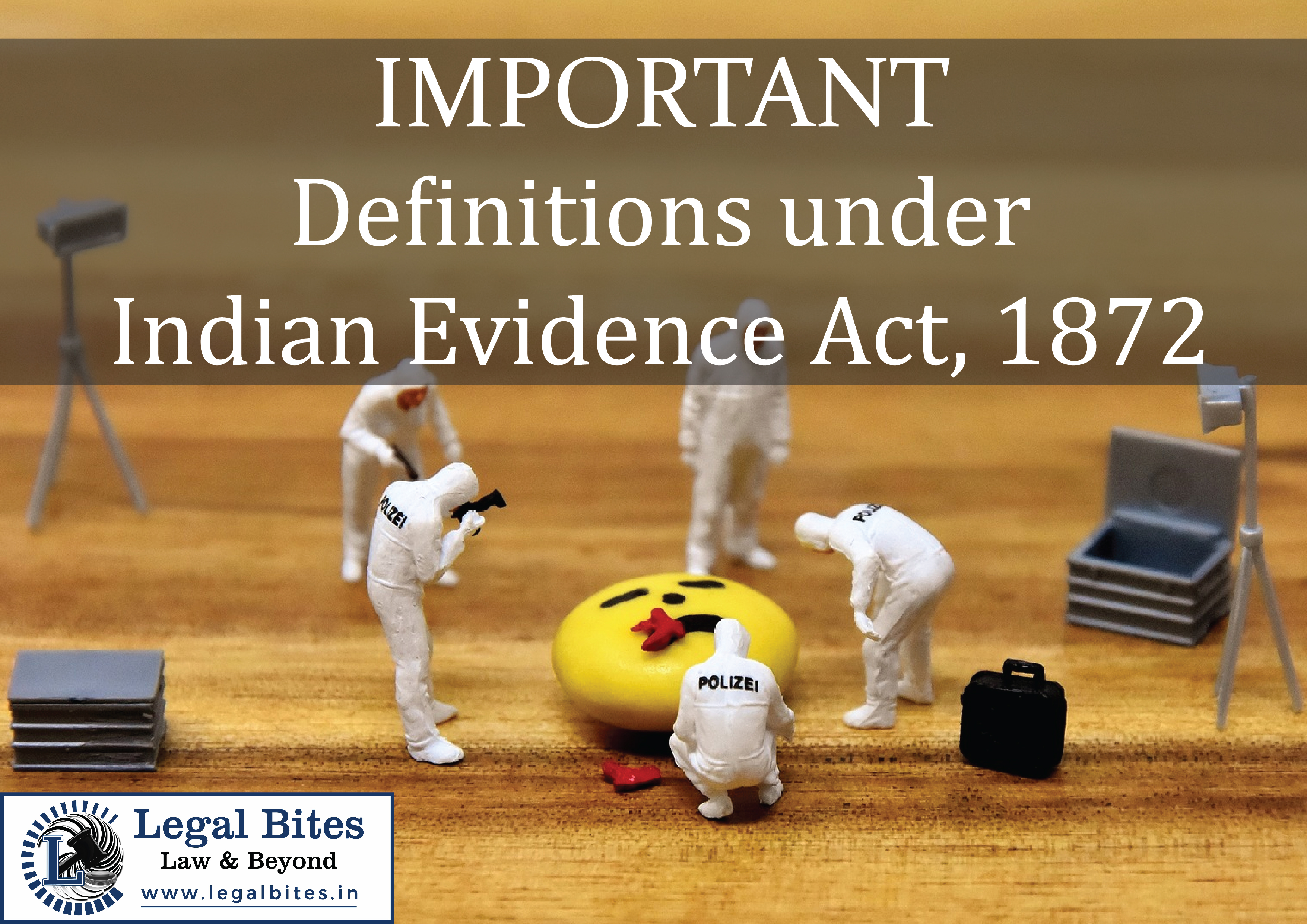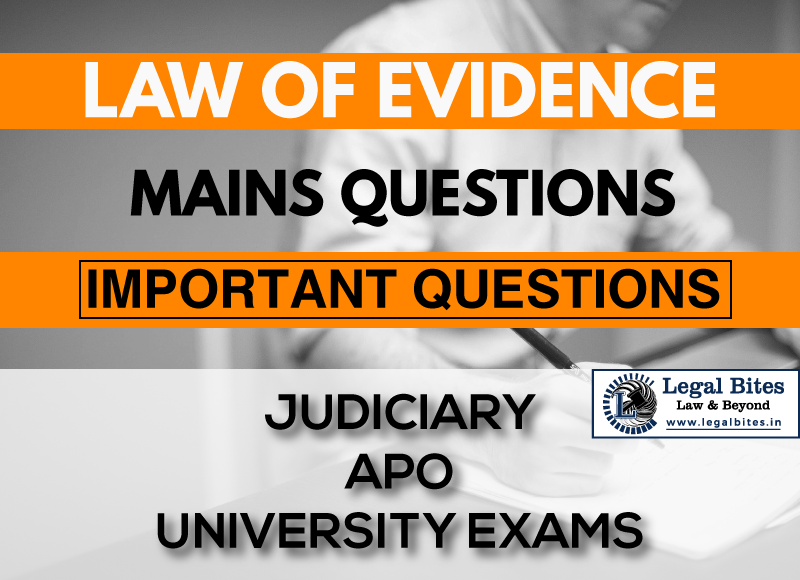Important definitions under Indian Evidence Act, 1872
This article on 'Important definitions under Indian Evidence Act, 1872' is written by Tejas Vasani and discusses some important concepts under the Indian Evidence Act, 1872. I. Introduction Section 3 of the Indian Evidence Act, 1872, defines certain important terms which must be understood in order to facilitate a better interpretation of the provisions of the Act. Let… Read More »
;
This article on 'Important definitions under Indian Evidence Act, 1872' is written by Tejas Vasani and discusses some important concepts under the Indian Evidence Act, 1872. I. Introduction Section 3 of the Indian Evidence Act, 1872, defines certain important terms which must be understood in order to facilitate a better interpretation of the provisions of the Act. Let us look at some of these important definitions. 1. Court The term "Court" is inclusive of the following: All Judges ...
This article on 'Important definitions under Indian Evidence Act, 1872' is written by Tejas Vasani and discusses some important concepts under the Indian Evidence Act, 1872.
I. Introduction
Section 3 of the Indian Evidence Act, 1872, defines certain important terms which must be understood in order to facilitate a better interpretation of the provisions of the Act. Let us look at some of these important definitions.
1. Court
The term "Court" is inclusive of the following:
- All Judges
- All Magistrates
- All persons legally authorized to take evidence, except arbitrators
It must be noted that a Magistrate committing a case to the Sessions Court falls within the ambit of the aforesaid definition of Court[1] whereas a Magistrate holding preliminary inquiry under section 164 of the Code of Criminal Procedure cannot be said to be 'Court'.[2]
2. Fact
The term "Fact" under the Evidence Act refers to the following:
- External Facts- Anything or state of a thing or relation of things that are capable of being perceived by the five senses.
- Internal Facts- Any mental condition regarding which a person is conscious of.
The section further consists of the following illustrations–
- The arrangement of certain objects in a certain order is a fact
- A man hearing or seeing something is a fact
- A man uttering certain words is a fact
- A man holding a certain opinion, having certain intention, acting in good faith or in a fraudulent manner, or using a particular word in a particular sense, or being or having been conscious of a particular sensation at a given time is a fact
- A man having a certain reputation is a fact
Events which have neither occurred in the past nor in the present but are likely to occur in the future does not fall within the ambit of the definition of "Fact" under the Indian Evidence Act, 1872.[3]
3. Relevant
Section 3 of the Indian Evidence Act, 1872, defines relevancy as "one fact is said to be relevant to another when the one is connected with the other in any of the ways referred to in the provisions of the Act relating to relevancy of facts."
The said provisions are contained in sections 5 to 55 of the Evidence Act.
A fact may either be logically relevant or legally relevant. Where a fact bears such casual relation to the other that it renders probable its existence or non-existence, it is said to be a logically relevant fact. For instance, where it is to be determined whether A has placed the murder weapon in the field or not, the fact that B saw A walking towards the field with the murder weapon is relevant.
The Evidence Act recognizes some of the kinds of causal relations. Thus, those kinds of causal relations which are recognized by law are known as legally relevant fact. Therefore, while all legally relevant facts are logically relevant, all logically relevant facts may not be legally relevant.
For instance, an accused gives the following statement- "I have kept in the field the knife with which I killed A."
While the statement may be logically relevant to establish the guilt of the accused, its legal relevancy extends only so far as it confirms the fact that the accused had kept the knife in the field. This is so because section 27 of the Evidence Act clearly lays down that only that part of the information may be proved which clearly relates to the fact thereby discovered.[4]
4. Facts in Issue
The expression "Facts in issue" refers to facts out of which a legal right, liability or disability arises and such legal right, liability, or disability is involved in the inquiry and upon which the Court has to give the decision. The question as to what facts may be "facts in issue" must be determined by substantive law or the branch of procedural law which deals with pleadings.[5] Generally, in criminal cases, the charge constitutes the facts in issue whereas in civil cases the facts in issue are determined by the process of framing of issues.
5. Evidence
Section 3 of the Indian Evidence Act, 1872 defines Evidence as – "––"Evidence" means and includes ––(1) all statements which the Court permits or requires to be made before it by witnesses, in relation to matters of fact under inquiry; such statements are called oral evidence; (2) all documents including electronic records produced for the inspection of the Court; such documents are called documentary evidence."
Evidence can be said to be any matter of fact which produces a persuasion in the mind regarding the existence and non-existence of some other matter of fact. Evidence may be oral, which refers to the testimony of witnesses, or documentary, which refers to the documents and electronic records tendered before the Court. The guilt of an accused may be proved using circumstantial evidence also.[6]
Circumstantial evidence refers to the indirect method of proving the guilt of an accused by drawing inferences from certain facts which are closely related to the facts in the issue. However, the standard of proof required for circumstantial evidence is quite high and courts are usually cautious while basing convictions upon circumstantial evidence.
Edited by- Akriti
References
[1] Atchayya v. Gangayya, (1891) 15 Mad 138 FB.
[2] Queen-Empress v. Bharma, (1886) 11 Bom 702 FB.
[3] Dueful Laboratory v. State, 1998 Cr LJ 4534 (Raj).
[4] Monir, M., Principles and Digest of Law of Evidence, 35 (1975); See Pulukuri Kotayya v. Emperor, AIR 1947 PC 47.
[5] Stephen's Introduction to the Evidence Act, pp. 12, 13.
[6] Vilas Pandurang Patil v. State of Maharashtra, AIR 2004 SC 3562.


